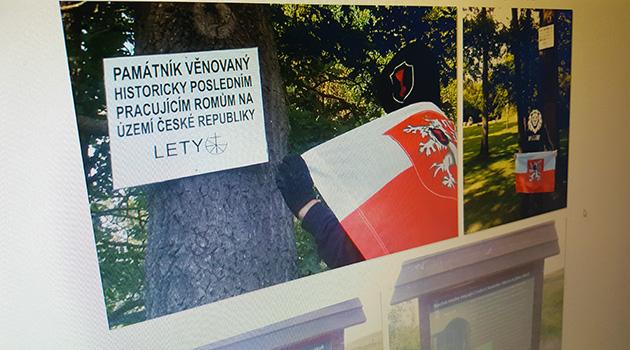Czech Police: Anti-Romani signs at Romani genocide memorial in Lety were approval of genocide, perpetrators face three years in prison

Police have charged two men with placing insulting signs about Romani people at the memorial in Lety u Písku in May of this year and say that by doing so, they have committed the crime of denying genocide. The men face up to three years in prison if convicted.
Both of the accused have complained against the charges. “Detectives in Písek, specifically, an investigator with the Criminal Police and Investigation services, issued at the end of last week a resolution on the initiation of a criminal prosecution, specifically of two young men, for felony denial, doubting, approval and justification of genocide,” the spokesperson for the Písek Police, Kamila Čuřínová Ingrišová, told Czech Television on 13 November.
The memorial at Lety was desecrated with insulting anti-Romani signs at the end of May, posted to some of the information boards by the nationalist group “Us against Everybody” (My proti všem). The group posted one sign on a tree near the memorial reading “This memorial is dedicated to the historically last Roma ever to work on the territory of the Czech Republic.”
On the signage by the information trail explaining the history of the former concentration camp, the extremists posted a second such sign of their own with the same message. The group admitted to having desecrated the memorial on their own website, where they belittled the suffering of Romani people in the Lety concentration camp.
“Through this project we want to point out the absurdity of investing half a billion crowns into a non-Czech ethnic group who most probably during the entire time of their existence in our country (1918-2018) have never contributed anywhere near that much money to the state budget!” reads the website of the group, which was established by Matouš Bulíř. In contradiction of the actual historical facts, the group said its signs were meant to draw attention to the fact that “this was not a concentration camp as some media and politicians are saying, but a labor camp.”
From the history of the concentration camp at Lety u Písku
The original grounds of the facility at Lety u Písku served in the year 1940 as an accommodation facility for construction workers. After that it was used for a disciplinary labor camp on the orders of the Interior Minister of the Government of the Protectorate of Bohemia and Moravia, Josef Ježek, dated 15 July 1940, which was issued on the basis of Czechoslovak Government edict no. 72, “on disciplinary labor camps”, dating from 2 March 1939.
That edict had been promulgated prior to the Nazi occupation. According to the edict, “wandering gypsies capable of work and other vagabonds living that same way, professional beggars, persons living from begging done by others (children, etc.), professional gamblers, notorious bums and loiterers, and persons living from dishonorable profits (prostitution, etc.), whether their own or those of others” were to be forcibly interned in the disciplinary labor camps.
The first 12 prisoners were sent to the one at Lety on 17 July 1940. About 10 % of them were Romani.
On 1 August 1942 the camp was turned into a “Gypsy Camp” and entire Romani families were then forcibly transported there. Lety began to function as a concentration camp on 1 August 1942 and was closed on 4 May 1943.
The capacity of the “Gypsy Camp” had been increased to make it able to house as many as 600 prisoners, but that number was soon exceeded, as during August 1942 more than 1 100 children, men and women were interned there. The camp was not equipped with the necessary hygienic or other kinds of facilities for such a high number of people.
The prisoners frequently had to bathe in the nearby fish pond. Prior to August 1942, only men had been imprisoned at the facility.
Beginning in August 1942, under absolutely unsatisfactory conditions, children and women were brought to Lety and left there to rot as well. After the big intake in August 1942, those subsequently forced into the camp arrived there just a family or an individual at a time.
At least 326 people died directly in the camp at Lety, 241 of them children. There were 120 victims of the camp buried in a mass grave somewhere near it.
Some survivors, however, have given higher numbers for the prisoners who perished at the camp. Another 540 Lety prisoners perished after being forcibly transported to Auschwitz.
A total of two mass transports to Auschwitz happened from Lety. The first one departed on 3 December 1942, a transport of so-called “asocials” numbering 16 men and 78 women, for the Auschwitz I concentration camp.
The second transport resulted in the camp at Lety being practically completely emptied, because it involved 417 prisoners being sent to the Auschwitz II – Birkenau concentration camp. While the first transport was implemented on the basis of a decree about crime prevention, the second was realized on the basis of Himmler’s decree from 16 December 1942 directing the transport of all Romani people to the Auschwitz concentration camp.
The remaining 198 Lety prisoners were then relocated to the “Gypsy Camp” at Hodonín u Kunštátu (the so-called “Žalov” site) or to internment camps in Pardubice and in Prague. On 13 May 1995, at the then-presumed location of the mass graves near the former camp, a memorial was unveiled with the inscription “To the victims of the Gypsy Camp at Lety, 1942-1943. Never forget. Ma bisteren.“
On 13 May 2010, the opening of the Lety Cultural Heritage Monument was officially announced at that location, which the Government first decided would be officially administered by the Lidice Memorial. The memorial site at Lety as well as the grounds of the former concentration camp are now administered by the Museum of Romani Culture.